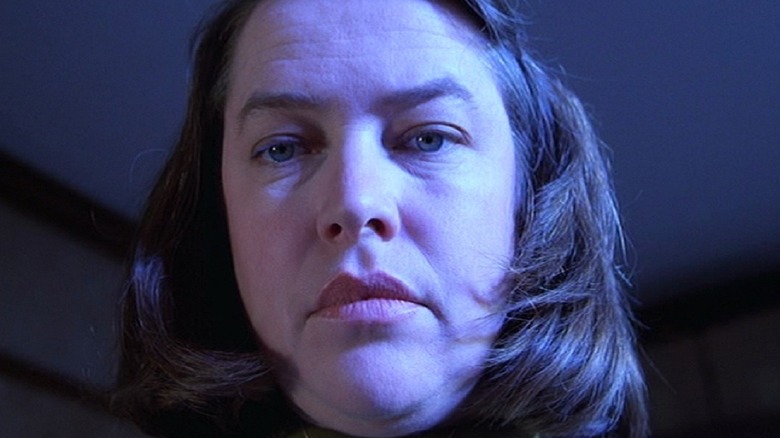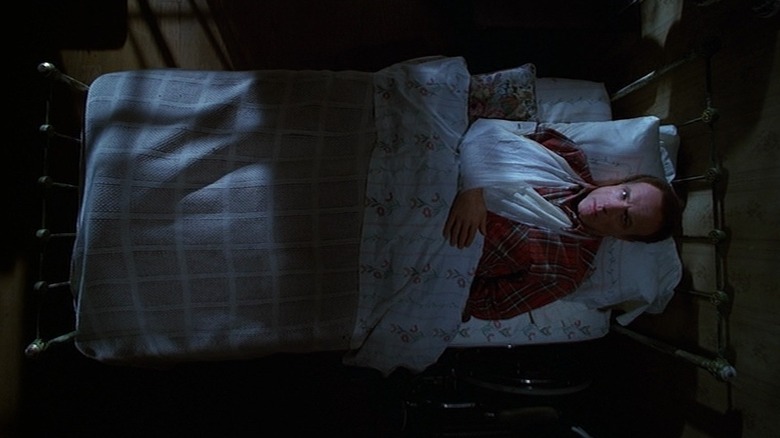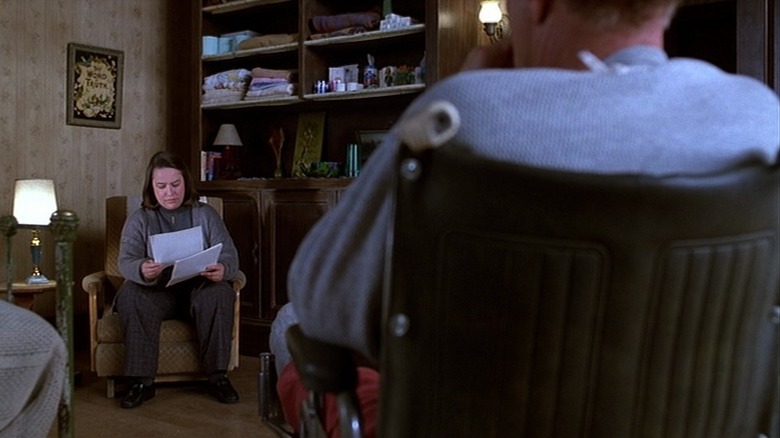Is Misery Based On A True Story?
In the works of Stephen King, it's common for there to be a writer caught up in the midst of all the horror. From "The Shining" to "Salem's Lot" to "It," there's often a struggling scribe thrown into chaos, and of all of King's published protagonists, none saw more trauma from the discomfort of a bed than romance novelist Paul Sheldon in "Misery."
Adapted for the big screen in 1990 by director Rob Reiner, "Misery" sees Sheldon (James Caan) driven off the road during a blizzard, only to be rescued by Annie Wilkes (Kathy Bates), who happens to be, as she puts it, Sheldon's biggest fan. Sheldon is severely injured and bedridden, which leaves him vulnerable when Wilkes' obsession with her wordsmith hero turns violent after she finds out that Sheldon plans to kill off Misery Chastain, the protagonist of his best-selling series of novels, and move onto other projects. Wilkes takes brutal advantage of Sheldon's incapacitated state to force him into reversing course and keeping her favorite character alive.
The film earned Bates an Academy Award for her terrifying, sledgehammer-wielding performance, which also helped established Wilkes as one of the great villains of modern cinema. But is there any truth to her? Is "Misery" is a work of fiction, or was there some fact to this nightmarish compulsory bed rest?
Misery drew inspiration from King's own drug addiction and his fans
Although the events of "Misery" aren't ripped from any real-life ordeal, the book itself (which King listed as one of his favorites during an interview on "The Late Show with Stephen Colbert") does appear to have been spawned from the writer's personal demons. King has openly admitted to going through an intense drug addiction, and since its original publication in 1987, King has spoken about how "Misery" is, in part, related to that struggle. Speaking to Rolling Stone in 2014, King said, "'Misery' is a book about cocaine. Annie Wilkes is cocaine. She was my number-one fan." The book clearly helped him work through some of his own personal issues, but past experiences with fans found their way into the pages, as well.
As noted in Rolling Stone, "Misery" was also inspired by the poor reaction King received from fans to his early fantasy novel "The Eyes of the Dragon." That book was a stark departure to what he had been known for up until that point, much like the novel Paul Sheldon begins working on after he kills off his fan-favorite character Misery Chastain. It wasn't just that Annie Wilkes was obsessed with Sheldon himself, she was also obsessed with his work, and much of her violence toward him stemmed from her anger at the idea that he would move on to writing a novel that she wasn't interested in reading.
However, that wasn't the only inspiration behind Annie Wilkes. There was a far darker bit of real-life history at play.
Was Annie Wilkes inspired by John Lennon's killer?
In a 1987 interview with The Washington Post, Stephen King recalled several unsettling fan encounters from throughout his career that helped inspire "Misery." Perhaps most notably was King's recollection of signing a photo for a fan in 1979 whose name he later learned was Mark Chapman. Although The Washington Post notes that the similar names are likely a coincidence, King came to believe that it could have been the same Mark Chapman who assassinated John Lennon in 1980 after asking for the legendary singer's autograph.
In the same interview, King also recalled another intense encounter with a fan, who yelled obscenities at King when he ignored his request for an autograph. "The line is so thin between 'I love you' and 'I hate you,'" King mused. "They love you, but part of them wants to see you fall as far as you can." This kind of temperament was clearly a key ingredient in the invention of Annie Wilkes, and in turn, the incredible performance of Kathy Bates in "Misery."


